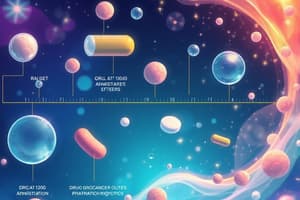Podcast
Questions and Answers
What is the maximum volume of drug that can typically be injected subcutaneously?
What is the maximum volume of drug that can typically be injected subcutaneously?
Typically, a maximum of 2ml of drug may be injected subcutaneously.
What is a key advantage of administering drugs via the intrarterial route?
What is a key advantage of administering drugs via the intrarterial route?
A key advantage is the rapid onset of action for the drug administered.
Identify one disadvantage of the inhalation route for drug administration.
Identify one disadvantage of the inhalation route for drug administration.
One disadvantage is that it can cause local irritation to the respiratory tract.
How does drug absorption differ in the oral route compared to the intramuscular route?
How does drug absorption differ in the oral route compared to the intramuscular route?
What is the bioavailability percentage when drugs are administered via the intrarterial route?
What is the bioavailability percentage when drugs are administered via the intrarterial route?
What is one reason why insulin is commonly administered subcutaneously?
What is one reason why insulin is commonly administered subcutaneously?
Explain one major limitation of the oral route of drug administration.
Explain one major limitation of the oral route of drug administration.
What is a critical disadvantage of using irritant drugs for intramuscular injections?
What is a critical disadvantage of using irritant drugs for intramuscular injections?
What is the primary advantage of using the oral route for drug administration?
What is the primary advantage of using the oral route for drug administration?
Describe one disadvantage of administering drugs via the rectal route.
Describe one disadvantage of administering drugs via the rectal route.
What mechanism primarily controls drug absorption in the body?
What mechanism primarily controls drug absorption in the body?
Why is intravenous administration considered to have high bioavailability?
Why is intravenous administration considered to have high bioavailability?
Identify one advantage and one disadvantage of intramuscular drug administration.
Identify one advantage and one disadvantage of intramuscular drug administration.
What is a key benefit of using inhalational drug delivery methods?
What is a key benefit of using inhalational drug delivery methods?
Explain how transdermal drug delivery works.
Explain how transdermal drug delivery works.
What distinguishes parenteral routes from enteral routes of drug administration?
What distinguishes parenteral routes from enteral routes of drug administration?
What are the main advantages of using the sublingual route for drug administration?
What are the main advantages of using the sublingual route for drug administration?
Why is intravenous (IV) administration considered to have 100% bioavailability?
Why is intravenous (IV) administration considered to have 100% bioavailability?
List two disadvantages of the intramuscular route of drug administration.
List two disadvantages of the intramuscular route of drug administration.
What is a limitation of the buccal route in drug administration?
What is a limitation of the buccal route in drug administration?
Explain the significance of avoiding first-pass metabolism in drug absorption.
Explain the significance of avoiding first-pass metabolism in drug absorption.
Why is the parenteral route often chosen for patients experiencing vomiting or diarrhea?
Why is the parenteral route often chosen for patients experiencing vomiting or diarrhea?
What makes inhalation drug delivery distinct from other routes of administration?
What makes inhalation drug delivery distinct from other routes of administration?
Identify an advantage and a disadvantage of subcutaneous drug administration.
Identify an advantage and a disadvantage of subcutaneous drug administration.
Flashcards
Intramuscular (IM) injection
Intramuscular (IM) injection
Drug administration into a muscle.
Intravenous (IV) injection
Intravenous (IV) injection
Drug administration directly into a vein.
Oral drug absorption
Oral drug absorption
Drug absorption through the digestive system (GI tract).
Subcutaneous (SC) injection
Subcutaneous (SC) injection
Signup and view all the flashcards
Inhalation drug delivery
Inhalation drug delivery
Signup and view all the flashcards
Drug absorption
Drug absorption
Signup and view all the flashcards
Drug bioavailability
Drug bioavailability
Signup and view all the flashcards
P-gp efflux transporter
P-gp efflux transporter
Signup and view all the flashcards
Who is considered the 'father of pharmacology'?
Who is considered the 'father of pharmacology'?
Signup and view all the flashcards
What is the first step of drug action?
What is the first step of drug action?
Signup and view all the flashcards
What are the major routes of drug administration?
What are the major routes of drug administration?
Signup and view all the flashcards
What are the advantages of oral drug administration?
What are the advantages of oral drug administration?
Signup and view all the flashcards
What are the disadvantages of oral drug administration?
What are the disadvantages of oral drug administration?
Signup and view all the flashcards
What is the 'cradle of experimental pharmacology'?
What is the 'cradle of experimental pharmacology'?
Signup and view all the flashcards
What is the importance of animal experimentation in pharmacology?
What is the importance of animal experimentation in pharmacology?
Signup and view all the flashcards
What are the advantages of rectal drug administration?
What are the advantages of rectal drug administration?
Signup and view all the flashcards
Sublingual Route
Sublingual Route
Signup and view all the flashcards
Buccal Route
Buccal Route
Signup and view all the flashcards
Parenteral Administration
Parenteral Administration
Signup and view all the flashcards
Intravenous (IV) Route
Intravenous (IV) Route
Signup and view all the flashcards
Intramuscular (IM) Route
Intramuscular (IM) Route
Signup and view all the flashcards
Subcutaneous (SC) Route
Subcutaneous (SC) Route
Signup and view all the flashcards
First-Pass Metabolism
First-Pass Metabolism
Signup and view all the flashcards
Bioavailability
Bioavailability
Signup and view all the flashcards
Study Notes
Pharmacology Chapter 1
- General pharmacology, introduction, and scope of pharmacology
- Various drug administration routes: advantages and disadvantages
- Definitions and scope of pharmacokinetics and pharmacodynamics
- Scope of pharmacology: toxicology, effect of poisons, methods for their detection, diagnosis, and treatment
- Chemotherapy, the branch of pharmacology dealing with drugs capable of destroying causative organisms without harming host cells
- Pharmacopoeia defines and describes established drugs and medical preparations
- History of pharmacology (Francois Magendie, 1783-1855 and Rudolf Buchheim, 1820-1879)
Introduction Definition and Scope of Pharmacology
- Pharmacology defined as the study of interactions between drugs and biological systems
- Derivation from Greek words "pharmakon" (drug) and "logos" (study)
- Covers drug history, source, biochemistry, physiological effects, mechanism of action, and uses of drugs
- Pharmacokinetics studies how the body interacts with the drug (absorption, distribution, metabolism, excretion)
- Pharmacodynamics studies how the drug interacts with the body (mechanism of action and pharmacological effect).
- Includes scope of Toxicology, the science of poisons,
- Chemotherapy, the mechanism of destroying causative organisms, and
- Pharmacopoeia, an official code with selected drugs and medical preparations.
Various Routes of Drug Administration
- Routes of drug administration are paths by which drugs enter the body.
- Examples include tablets, capsules, suspensions, ointments, creams, and injections.
- Routes include oral, parenteral, topical.
Oral Route
-
Drugs are swallowed with liquid or solid preparations
-
Advantages: most medical preparations are consumed orally, economical, convenient for children and adults, less chance of acute reaction
-
Disadvantages: can be inefficient for patients, can irritate the gastric mucosa, may cause nausea and vomiting
Rectal Route
- Drugs are administered in suppositories/ enemas via rectal route
- Advantages: useful in children and adults, useful in cases of vomiting, can achieve high drug concentration
- Disadvantages: may cause rectal irritation or inflammation, absorption is often slow and erratic (inconsistent).
Sublingual/ Buccal Route
- Dosage form is placed under the tongue or in the buccal cavity
- Advantages include rapid absorption, avoidance of first-pass metabolism, maintained drug stability, and less chance of infection
- Disadvantages: only small doses can be administered, absorption is sometimes incomplete.
Parenteral Administration
- Routes other than the enteral route (e.g., oral, rectal)
- Includes intravenous (IV), intramuscular (IM), subcutaneous (SC), and inhalational.
- Intravenous: rapid onset of action, 100% bioavailability, best in cases of diarrhea and vomiting
- Intramuscular: rapid onset, suitable for liquids, no GIT factors
- Subcutaneous: self-administration possible
- Inhalational: rapidly absorbed, used for anesthetic gases.
Intravenous route
- Drugs are directly injected into veins.
- Advantages: rapid absorption, high bioavailability, and suitable for emergencies.
- Disadvantages: risk of systemic infection.
Intra-arterial
- Drugs are administered into the arteries
- Advantages: immediate and rapid onset of action, useful for administering anticancer drugs.
- Disadvantage: limited to drugs administered via skin route.
Inhalation
- Drugs are inhaled as aerosols or vapors.
- Advantages: drugs directly absorbed from lungs into circulation, bypasses the first pass effect.
- Disadvantages: only for small particle drugs, unsuitable for insoluble particles.
Drug Absorption
- Absorption is the movement of a drug from administration site into the bloodstream.
- Factors affecting absorption: administration route, surface area of the absorbing surface, aqueous solubility
- Types of absorption: oral, parenteral, topical
Bioavailability
- The rate and extent of absorption.
- Affected by factors such as first-pass metabolism, solubility and degradation in the GI tract.
- Injection of drugs intravenously is almost 100% bioavailable.
- Oral administration may be incompletely absorbed by first-pass metabolism.
Factors affecting drug absorption
- Routes of administration, surface area of absorbing surface, aqueous solubility
- Concentration gradient, vascularity of surface
- Absorption sites like skin, cornea, and mucus membranes.
Drug Distribution
- The extent to which a drug spreads throughout the body.
- Affects by factors including: organ/tissue size and perfusion rate, drug binding to blood components/extracellular components, age, obesity, disease states
- Distribution also influences drug concentration in different organs/tissues.
Metabolism/Biotransformation of Drugs
- Chemical alteration of drugs within the body that changes drug structure and properties.
- Process occurs mainly in the liver.
- Types of metabolism include activation (converting inactive drugs into active ones), inactivation (rendering active drugs less active), and formation of metabolites (conversion into different compounds).
- Factors affecting drug metabolism include age, sex
Excretion
- Removal of drugs and metabolites from the body.
- Routes of excretion include the kidneys (urine), liver (bile), lungs (exhalation), sweat, saliva, and breast milk.
- Many factors affect excretion such as blood circulation, chemical properties of drug, and presence of metabolites.
- Factors include age, disease, and certain drugs.
Factors affecting drug metabolism
- Age, species, sex differences, enzyme induction and inhibition, and stereochemistry of drugs
General mechanisms modifying drug action
- Body size, age, sex, species, genetic predisposition, routes of administration, pregnancy/lactation
- Physiological states (e.g., kidney or liver diseases), dietary and environmental factors, psychological status, bioaccumulation, and tolerance/resistance.
Studying That Suits You
Use AI to generate personalized quizzes and flashcards to suit your learning preferences.




